Best A1C Range for Seniors: What’s Safe and Recommended?

Best A1C range for seniors is a crucial topic for older adults managing diabetes or prediabetes.
As we age, maintaining stable blood sugar becomes increasingly important especially for seniors who may be dealing with chronic conditions or limited mobility.
Table of Contents
One of the most reliable ways to track long-term blood sugar control is through the A1C test, which reflects your average glucose levels over the past two to three months.
But what exactly is considered a “good” or “safe” A1C level for seniors? Unlike younger adults, older individuals often need adjusted A1C targets that take into account their overall health, mobility, and risk of complications like hypoglycemia.
In this article, we’ll break down the best A1C range for seniors, explain how those numbers change with age and health conditions, and provide actionable tips to help maintain ideal levels.
Whether you’re an older adult or a caregiver, this guide offers science-backed insights to support better blood sugar control and overall well-being.
Let’s explore what the latest medical guidelines recommend and what’s truly safe when it comes to A1C goals in older adults.
One of the most reliable ways to track long-term blood sugar control is through the A1C test, which reflects your average glucose levels over the past two to three months.
👉 Learn more from the CDC
If you’re wondering what’s considered a safe or risky value, we also covered this in detail in our guide on
👉 Normal A1C Levels for Seniors
What Is the Best A1C Range for Seniors?
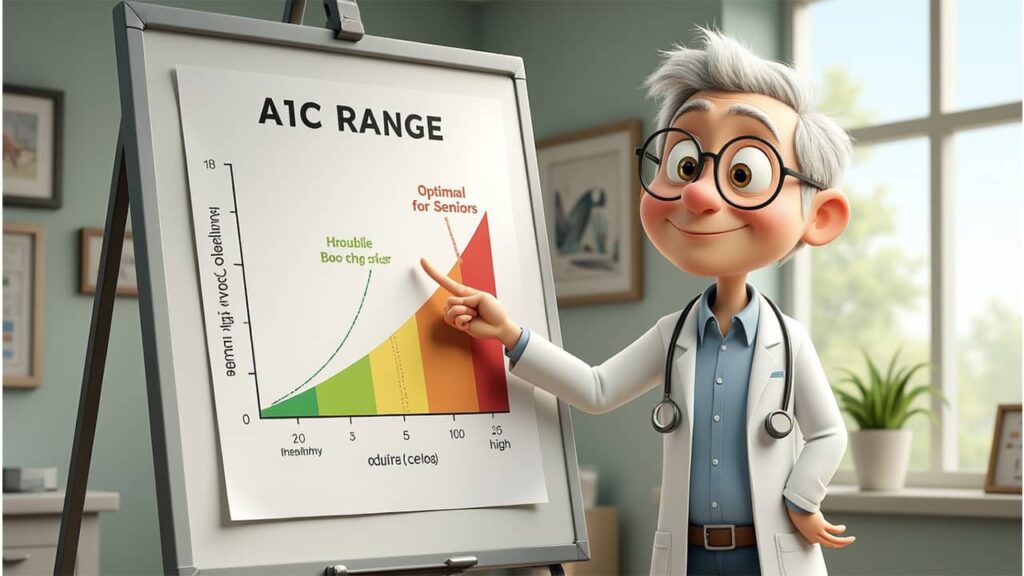
The best A1C range for seniors is not a one-size fits-all number. Instead, it’s a target that depends on each person’s overall health, risk of hypoglycemia, and life expectancy.
According to the American Diabetes Association (ADA) and other medical organizations, most healthy older adults should aim for an A1C between 7.0% and 7.5%.
However, for seniors with multiple chronic conditions, limited mobility, or a higher risk of low blood sugar, a more relaxed A1C target around 7.5% to 8.0% may be safer and more realistic.
In very frail or terminally ill individuals, strict glucose control is often discouraged to avoid the dangers of hypoglycemia.
In simple terms, the recommended A1C for elderly people should be tailored to their personal needs.
This means your ideal A1C may look different from someone else’s, and that’s completely okay. The key is finding a safe and sustainable range in consultation with your healthcare provider.
A1C Guidelines for Healthy, Frail, and Complex Seniors
Based on current geriatric diabetes guidelines, here are the typical A1C recommendations:
📊 Gutenberg Table: Recommended A1C Ranges by Health Status
| Health Status | Recommended A1C Range |
|---|---|
| Healthy & Independent | 7.0% – 7.5% |
| Frail or with comorbidities | 7.5% – 8.0% |
| Complex/End-of-life care | < 8.5% or individualized |
These recommendations are not rigid rules, but clinical benchmarks designed to minimize complications like heart disease, stroke, and hypoglycemia.
Seniors who are active, cognitively well, and independent can manage tighter A1C control.
On the other hand, older adults with memory issues, poor nutrition, or multiple medications may benefit more from a looser A1C range that prioritizes safety and quality of life.
This nuanced approach ensures the best A1C range for seniors respects the individual’s needs, not just the numbers on a chart.
Why the Best A1C Range for Seniors Differs From Younger Adults

Many people assume that blood sugar goals are universal, but that’s not the case especially for older adults.
The best A1C range for seniors differs from that of younger individuals due to several age related factors, including declining kidney function, cognitive changes, reduced physical activity, and increased sensitivity to hypoglycemia.
Seniors are also more likely to be taking multiple medications, have chronic conditions like high blood pressure or heart disease, and experience changes in diet or nutrition.
All of these elements influence how tightly or loosely blood glucose should be controlled.
In fact, aggressive A1C targets that are safe for a 40 year old can be risky for a 75 year old. Why?
Because a lower A1C might increase the chance of dangerous lows (hypoglycemia), which in older adults can lead to falls, fractures, confusion, or hospitalization.
That’s why medical professionals often advise individualized A1C goals based on the senior’s functional status and overall health not just age alone.
Tips to Maintain a Healthy A1C Range in Seniors
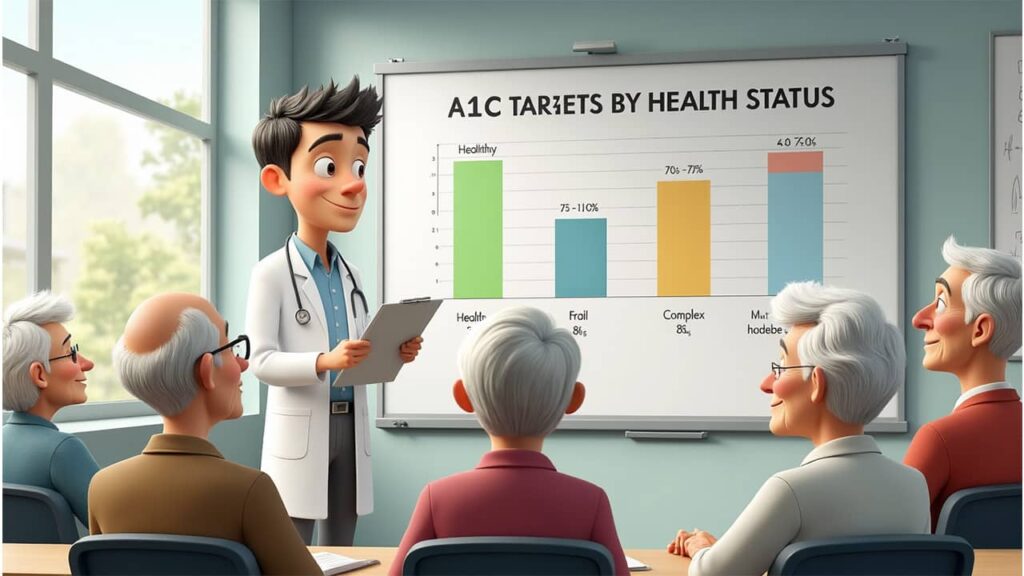
Keeping blood sugar levels within the best A1C range for seniors doesn’t have to be complicated but it does require consistency.
The good news is that even small changes in daily habits can make a big difference. Here are some medically supported strategies that older adults can use to help maintain optimal A1C levels:
🥗 1. Choose a Senior-Friendly Balanced Diet
Focus on meals rich in fiber, lean proteins, and healthy fats. Complex carbohydrates like whole grains and legumes help maintain more stable blood sugar levels than processed foods. Seniors should avoid skipping meals and watch portion sizes to prevent blood sugar spikes or drops.
🏃♂️ 2. Stay Active, Within Your Limits
Physical activity helps improve insulin sensitivity. Even light daily movement like walking, gentle yoga, or water aerobics can support the recommended A1C for elderly people. Exercise also benefits joint mobility, balance, and overall cardiovascular health.
💊 3. Monitor Blood Sugar and Follow Medication Plans
Regular A1C testing and at home glucose monitoring help track progress. Seniors should take medications exactly as prescribed and report any side effects or unusual readings to their healthcare provider. Proper medication timing is key to staying within the healthy A1C target for seniors.
🌿 4. Consider Supportive Supplements
Some natural supplements may aid blood sugar regulation. For example, NuviaLab Sugar Control combines clinically studied ingredients that may help support glucose metabolism in adults, including seniors. While not a substitute for medication, it can be a helpful addition to a healthy lifestyle always consult with your doctor first.
😴 5. Prioritize Sleep and Stress Reduction
Poor sleep and chronic stress can both impact blood sugar control. Seniors should aim for 7–8 hours of quality sleep and engage in relaxing activities such as reading, breathing exercises, or time with loved ones. Mental health matters just as much as physical health when managing A1C.
Incorporating these habits consistently can help seniors remain within the best A1C range, reduce complications, and improve overall well being. Remember: slow and steady progress is more sustainable than extreme changes.
A1C Chart by Age: What’s Typical for Seniors?
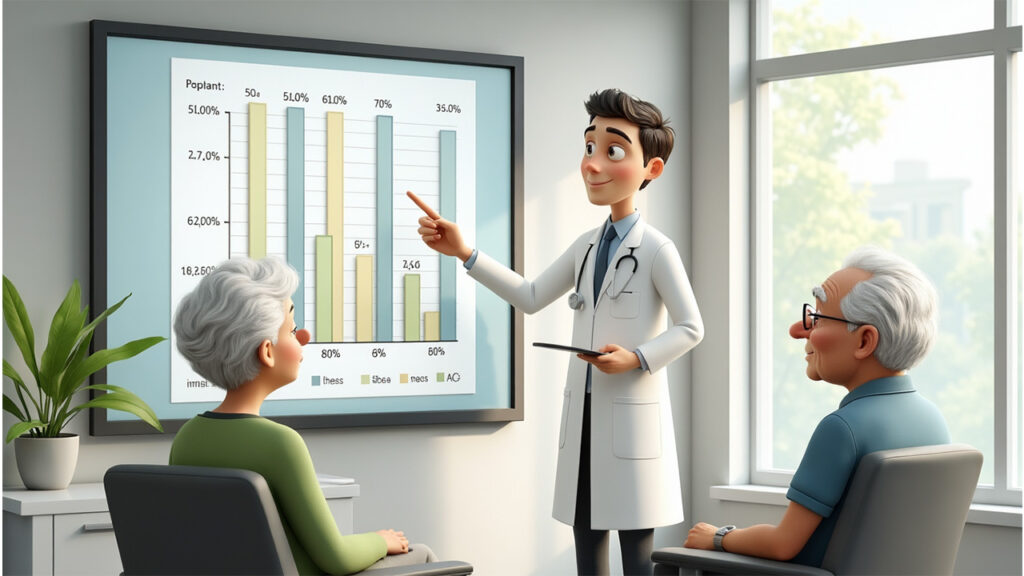
Understanding what A1C levels are typical by age can help seniors and caregivers interpret lab results more accurately.
While the best A1C range for seniors depends on overall health, age itself plays a role in determining what’s normal or acceptable.
As we age, the body’s ability to regulate blood sugar can change due to factors like hormonal shifts, reduced insulin sensitivity, and decreased physical activity.
Below is a general reference chart that outlines average A1C levels by age:
📊 Gutenberg Table – Average A1C Levels by Age
| Age Group | Normal A1C Range | Notes |
|---|---|---|
| 50–59 years | 5.0% – 5.6% | Typical range for healthy, active individuals |
| 60–69 years | 5.3% – 6.0% | Slightly elevated due to metabolic and hormonal changes |
| 70–79 years | 5.5% – 6.3% | Higher range may be considered safe if no complications |
| 80+ years | 5.8% – 6.5% | Frailty or chronic conditions may justify higher targets |
👉 BMC Endocrine Disorders – A1C variation by age
Keep in mind that these are general population averages not clinical targets. Seniors with diabetes may have higher recommended goals based on individual circumstances. To learn more about the ideal targets, check out our full guide on
👉 Normal A1C Levels for Seniors
Discuss your A1C results with a healthcare provider who can evaluate them in the context of your full medical history, medications, and daily lifestyle.
A1C vs Fasting Glucose: What’s More Reliable for Seniors?
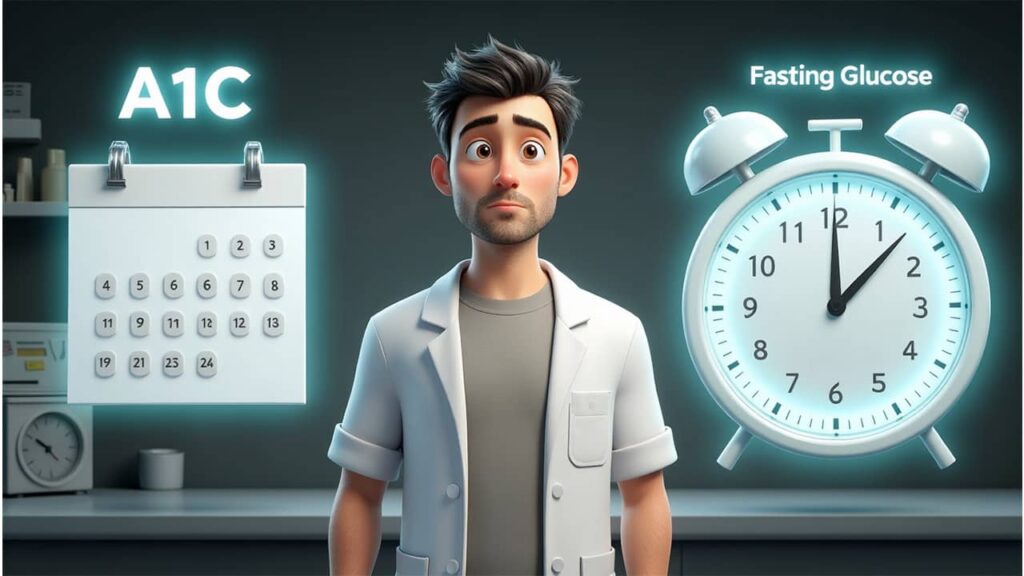
Seniors managing diabetes or prediabetes often wonder whether the A1C test or fasting glucose test is the best way to track their blood sugar.
While both are important, they serve different purposes and understanding the difference can help improve long term management.
The A1C test shows your average blood sugar levels over the past 2 to 3 months. In contrast, a fasting glucose test measures your blood sugar at a single point in time, usually after 8 hours without food.
For seniors, the A1C test is often considered more reliable, especially if daily testing is difficult or if meals and routines vary. It gives a more complete picture of glucose control and helps guide medication decisions.
📊 Gutenberg Table – A1C vs Fasting Glucose for Seniors
| Test Type | What It Measures | How It’s Used | Best For |
|---|---|---|---|
| A1C Test | 2–3 month average glucose | Every 3–6 months | Long-term diabetes control |
| Fasting Glucose | Glucose at the moment (after fasting) | Daily/weekly or as needed | Spot-checks or confirming diagnosis |
| Reliability in Seniors | High (less day-to-day variation) | Better for those with irregular routines | Monitoring therapy progress |
| Drawbacks | May not reflect acute lows or highs | Not useful for real-time adjustment | Needs lab test |
If you’re unsure which test is more appropriate for you, speak with your doctor. Many care plans for older adults use both tests A1C for long term tracking and fasting glucose for day-to-day insights.
Ultimately, keeping A1C within the best A1C range for seniors remains the top priority for minimizing complications like nerve damage, kidney disease, or vision problems.
How to Talk to Your Doctor About Your A1C Goals

Knowing your A1C number is one thing understanding what it means for your health is another.
For seniors, it’s essential to have clear, honest conversations with their healthcare providers about what A1C goals are realistic, safe, and tailored to their specific needs.
Doctors often follow general guidelines, but you have the right to ask questions, express concerns, and request individualized targets based on your lifestyle, age, medications, and personal health history.
🗣️ Tips for an Effective Conversation with Your Doctor
- Bring your latest test results or glucose logs to your appointment.
- Ask directly: “What is the best A1C range for someone my age and condition?”
- Mention symptoms like dizziness, fatigue, or low energy that might be signs of low or high blood sugar.
- Be honest about your eating habits, medication adherence, and physical limitations.
- Request clarification if the doctor uses unfamiliar terms or numbers.
- Discuss options such as diet changes, medication adjustments, or the addition of supplements.
Common Mistakes Seniors Make When Managing A1C
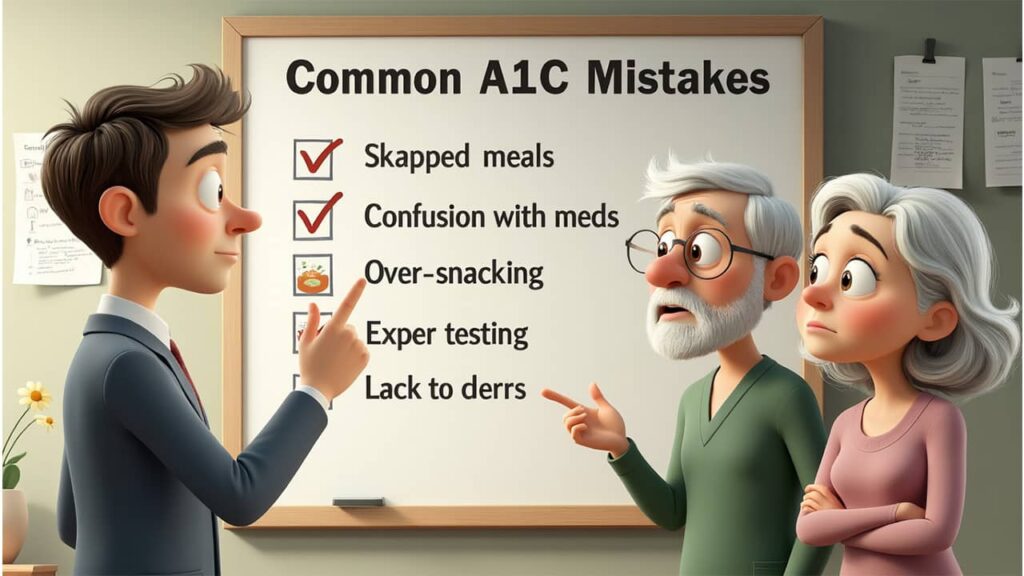
Managing blood sugar isn’t easy especially as we age. Even well intentioned seniors often make simple mistakes that can interfere with reaching or maintaining the best A1C range for seniors.
Being aware of these pitfalls can make all the difference in long term health.
❌ 1. Skipping Meals to “Lower” Blood Sugar
Some older adults mistakenly believe that eating less will reduce their A1C. In reality, skipping meals can lead to blood sugar spikes or dangerous lows, especially when taking insulin or other glucose-lowering medications.
❌ 2. Overcorrecting with Sugary Snacks
When feeling weak or dizzy, it’s easy to reach for a soda or candy bar but that overcorrection can cause a blood sugar rollercoaster. Always treat lows with measured amounts of glucose and monitor closely.
❌ 3. Ignoring Medication Side Effects
Seniors often take multiple medications, and interactions can affect glucose control. Not discussing side effects or forgetting to take meds can lead to erratic A1C levels.
❌ 4. Not Testing Frequently Enough
Only checking blood sugar during doctor visits isn’t enough. Seniors should follow their provider’s recommendation for A1C testing every 3 to 6 months, and may benefit from daily monitoring.
❌ 5. Relying Solely on Medication Without Lifestyle Support
Medications are helpful, but diet, activity, and stress management matter too. Adding support tools like NuviaLab Sugar Control a supplement with ingredients that support glucose metabolism can be beneficial, especially when combined with healthy habits. Always consult your doctor before starting any supplement.
❌ 6. Failing to Adjust Goals as Health Changes
The A1C goal you had at 60 may not be appropriate at 80. As mobility, medications, or cognitive function evolve, so should your diabetes care plan.
Staying informed, proactive, and open to adjustment is the best way to stay within the recommended A1C for elderly individuals.
Learning from these common mistakes helps seniors gain more control over their blood sugar and their quality of life.
With the right habits and support, achieving the best A1C range for seniors is not only possible, but sustainable.
Conclusion: Finding and Maintaining the Best A1C Range for Seniors
Reaching and maintaining the best A1C range for seniors is not about chasing perfection it’s about finding the safest and most realistic target for your body, your lifestyle, and your long-term health.
While general guidelines exist, the ideal A1C will vary depending on your age, functional status, medications, and risk of complications.
That’s why seniors should always work with their doctors to set personalized A1C goals that reflect their unique needs.
Along the way, small lifestyle changes can make a big difference.
Eating balanced meals, staying active, managing stress, and using blood sugar tracking tools can all support better outcomes.
For some seniors, adding a targeted supplement like NuviaLab Sugar Control may offer additional support when used responsibly and under medical supervision.
Most importantly, remember: good A1C management is not a one-time event. It’s an ongoing journey one where knowledge, consistency, and support are your strongest allies.
📌 Next step for the reader:
✳️ Talk to your healthcare provider about your current A1C.
✳️ Revisit your goals and daily habits regularly.
✳️ Consider tools that help you take control naturally and safely.





